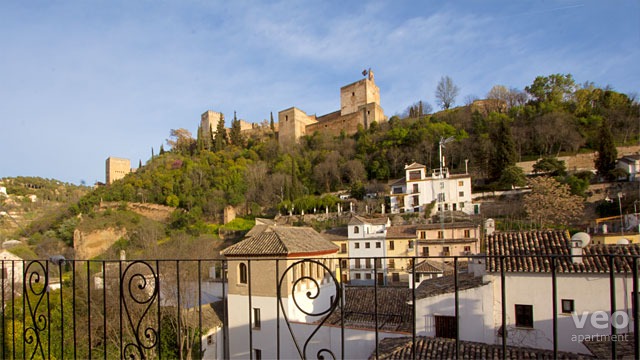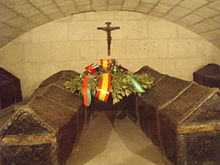Although famous first and foremost for the great fortress and palace of the Alhambra, Granada is by no means a “one-horse town”, and has a wealth of history and culture to discover in its streets and monuments, and also in its many museums.
 view of the Alhambra from our Carnero apartment in the Albaicin
view of the Alhambra from our Carnero apartment in the Albaicin
Until the 11th century Granada was a minor provincial town in the Caliphate of Córdoba, but in the mid 13th century, after the defeat of the Almohads (Moorish Kings of Seville) by the Christians, it became the capital of the Nasrids, the last Moorish rulers of Spain. They took over a small hilltop fortress called the Alhambra, and in the course of two centuries turned it into one of the most spectacular places on earth.
Two of Granada’s most important museums, the Alhambra and the Fine Arts are actually housed in the Carlos V Palace in the Alhambra complex. The Alhambra Museum has a large collection of ceramics and other objects used in the Nasrid palace complex, and of Mudejar art in general. The Fine Arts Museum has a collection of paintings and sculptures by artists such as Alonso Cano.

entrance to patio of Casa Castril
If you want to go right back to the beginning, the Archaeological Museum is the place to be. It has a huge collection of objects from the paleolithic era through to the end of the Moorish period. This museum is currently closed for renovations, though some of the exhibits can be seen at the Museo de la Memoria de Andalucia.
If modern is more your style you may want to visit the Science Museum. This is also a great one for the children, with lots of activities and interactive displays to awaken their interest in how things work. There’s a planetarium, and sections on the biosphere, perception and exploration, and also an observation tower that looks out over the city.
The Jewish contribution to the religious, cultural and intellectual life of late mediaeval Granada is remembered in two museums, the Sefardi Museum in the old Jewish neighbourhood of the Realejo, and the Palacio de Los Olvidades (the forgotten). Both give an insight into the daily life of the Jews in Granada, with collections of domestic and religious items and lots more.
For a closer look at the life of the Moors in Granada, pay a visit to the recently opened Casa de Zafra, a Nasrid mansion in the lower Albaicin that was incorporated into a convent. The tranquil courtyard with a pool is typical of the architecture of the period, and makes you feel as if you’ve stepped back in time.

Coffins of the Catholic Kings (courtesy of Wikimedia)
Coming into the Christian period, the Royal Chapel (next to the Cathedral), has a collection of Royal and personal belongings of the Catholic monarchs Ferdinand and Isabella, while the Casa de Los Pisa is home to the Museum of Juan de Dios (John of God).
Another very popular museum is the Sacramonte, which looks at life in the “Gypsy” neighbourhood of the Sacramonte. The area is famous for its cave houses, and the museum recreates a cave house of 100 years ago, and includes lots about the history of the neighbourhood and of Granada. There are also stunning views of the Alhambra and Albaicin from the area around the museum, that are worth making the journey for all by themselves.
Alhambra Museum and Fine Arts Museum
Palacio Carlos V
Tel: +34 958 027 900/929
Archaeological Museum (Casa de Castril)
Carrera del Darro, 41
Tel: +34 958 225 603
Science Museum
Avenida del Mediterraneo, s/n
Tel: +34 958 131 900
Museo Sefardi
Placeta Berrocal, 5
Tel: +34 958 220 578
Palacio de los Olvidades
Cuesta de Santa Inés, 6
Tel: +34 958 100 840
Casa de Zafra
Portería de la Concepción, 8
Tel: +34 958 180 079
Royal Chapel
Plaza de la Lonja, Gran Via, 5
Tel: +34 958 222 959
Juan de Dios (Casa de los Pisa)
Convalencia, 1
Tel: +34 959 222 144
Sacramonte Caves
Barranco de los Negros, s/n
Tel: +34 958 215 120
